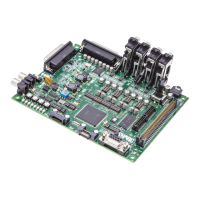ADSP-214xx SHARC Processor Hardware Reference 7-15
Pulse Width Modulation
In other words, both
PWM_AL and PWM_AH or PWM_BL and PWM_BH should be
enabled and both should have same polarity for proper operation of
cross-over mode.
Emergency Dead Time for Over Modulation
The PWM timing unit is capable of producing PWM signals with variable
duty cycle values at the PWM output pins. At the extreme side of the
modulation process, settings of 0% and 100% modulation are possible.
These two modes are termed full OFF and full ON respectively.
Full OFF and full ON over-modulation is entered by virtue of the
commanded duty cycle values in conjunction with the setting in
the PWMDTx registers. Settings that fall between the extremes are
considered normal modulation. These settings are explained in
more detail below.
Full On. The PWM for any pair of PWM signals operates in full on when
the desired high side output of the two-phase timing unit is in the on state
(low) between successive PWM interrupts.
Full Off. The PWM for any pair of PWM signals operates in full off when
the desired high side output of the two-phase timing unit is in the off state
(high) between successive PWMSYNC pulses.
Normal Modulation. The PWM for any pair of PWM signals operates in
normal modulation when the desired output duty cycle is other than 0%
or 100% between successive
PWMSYNC pulses.
There are certain situations, when transitioning either into or out of either
full on or full off, where it is necessary to insert additional emergency dead
time delays to prevent potential shoot-through conditions in the inverter.
These transitions are detected automatically and, if appropriate, the emer-
gency dead time is inserted to prevent the shoot through conditions.

